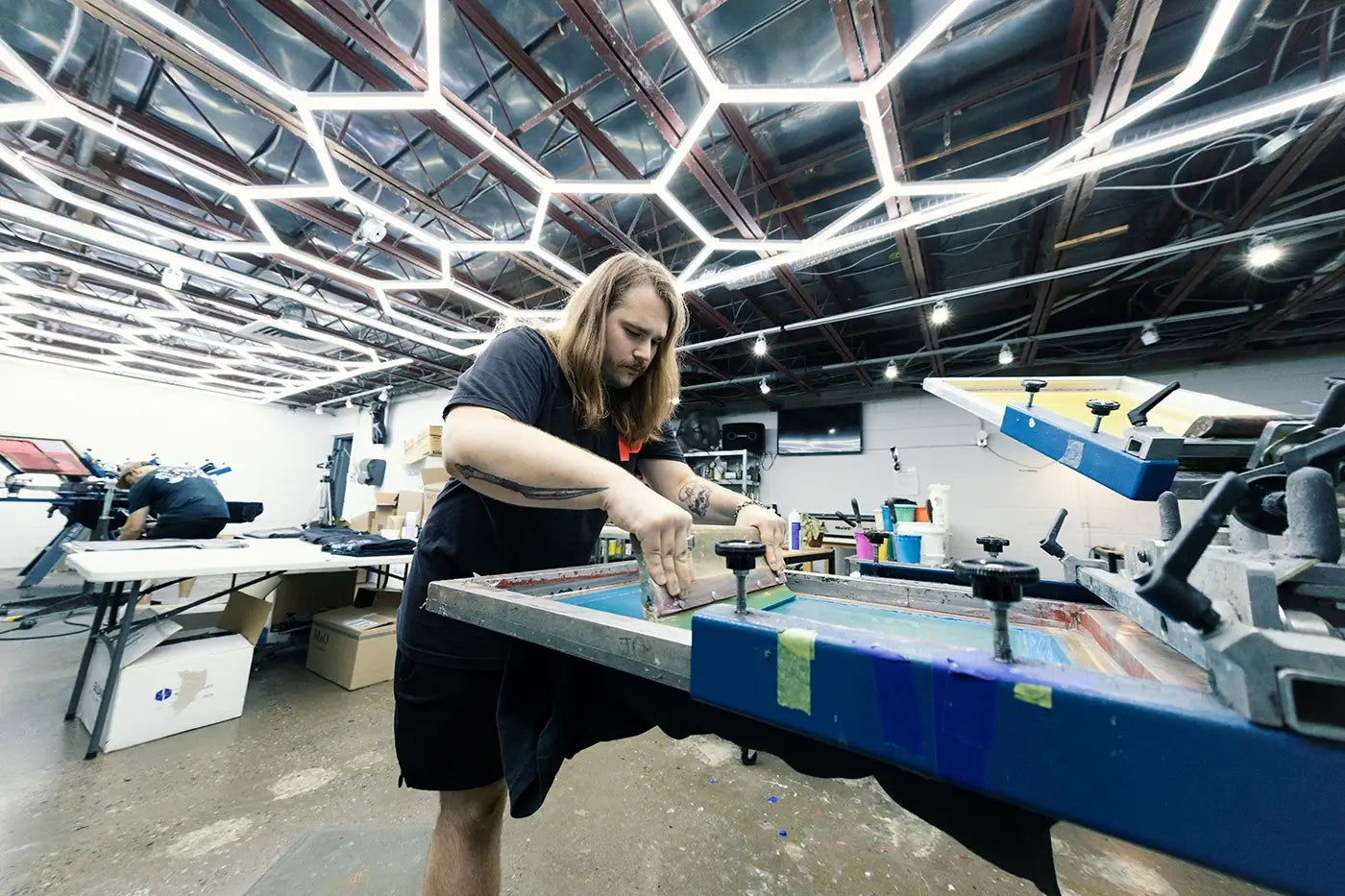Silk Screen Printing for Bold and Lasting Designs
Silk Screen Printing for Bold and Lasting Designs
Blog Article
Display Printing Uncovered: Everything You Required to Learn About T-Shirt and Garment Printing Methods
Display printing is a remarkable approach that incorporates art with method, using limitless opportunities for imagination. Prepared to explore the essential components that make display printing an art kind?
The Basics of Display Printing: Exactly How It Works
When you dive right into display printing, you'll find it's both an art and a science. At its core, display printing includes creating a pattern, or screen, that allows ink to pass through just in particular locations (screen printing kit). You begin by selecting your design and preparing your display with a light-sensitive emulsion. As soon as you subject this emulsion to light, it hardens, leaving your style as a negative room.
Placement the screen over the fabric, then utilize a squeegee to press ink through the screen onto the garment. Each action is necessary, and grasping them will certainly raise your screen printing skills, transforming easy garments into special, meaningful items.
Sorts Of Display Printing Techniques
As soon as you understand the basics of display printing, it's time to explore the various methods that can elevate your styles. One popular method is standard display printing, where ink is pressed via a stenciled display. This method is excellent for strong, vibrant shades. There's water-based ink printing, which provides a softer feel and is environment-friendly, but it needs a different strategy to treating.
One more alternative is plastisol printing, known for its toughness and vivid colors, making it a preferred for lots of brand names. Experiment with halftone printing to develop gradient effects and intricate designs.
Essential Tools for Screen Printing
To accomplish magnificent outcomes in display printing, having the right equipment is fundamental. You'll need a tough screen printing frame, which holds the mesh that moves your design onto the garment. Next off, invest in high-grade mops; these are essential for using ink equally throughout the display.
Selecting the Right Inks and Products
When picking inks and materials for display printing, you require to take into consideration the sort of ink that works finest for your project. Think of fabric compatibility to assure your layouts look last and wonderful lengthy. Additionally, check out eco-friendly ink options to make your printing process more lasting.
Kinds Of Screen Inks
Picking the best display ink is vital for achieving vibrant, durable prints that fulfill your job's needs. There are several types of display inks to analyze. Specialty inks, such as glow-in-the-dark or metal, can include one-of-a-kind impacts to your styles.

Material Compatibility Factors To Consider
Comprehending textile compatibility is crucial for achieving high-grade display prints, specifically considering that different products react distinctly to different inks. When selecting inks, take into consideration the textile type-- cotton, polyester, or blends. For cotton, water-based inks work well, providing soft qualities and breathability. Polyester, on the various other hand, frequently requires plastisol inks for much better attachment and lively colors. You might need to utilize a combination of both types if you're publishing on blends. Constantly examine your inks on sample fabric to guarantee they adhere appropriately and maintain color honesty. Furthermore, remember that textile weight and texture can affect the last end result, so choosing the best ink and material combo is essential for your task's success.
Eco-Friendly Ink Options
Eco-friendly inks are coming to be a prominent selection for screen printers who desire to decrease their ecological impact while keeping high quality. When choosing inks, consider water-based inks, which are less harmful and easier to cleanse up contrasted to typical solvents.
Furthermore, seek inks made from renewable energies, such as soy or vegetable-based alternatives. By picking the right inks and materials, you'll not just produce sensational designs yet likewise add to a much more lasting printing process. Make the switch, and your prints will mirror your dedication to the setting!
Preparing Your Layout for Screen Printing

Submit Format Requirements
To guarantee your design looks sharp and like it dynamic on fabric, you'll require to pay close interest to file style needs for screen printing. Make certain your design has a transparent background to prevent undesirable white edges on your prints. Keep shade modes in mind; CMYK is typical for screen printing, so transform your RGB creates as necessary.
Shade Splitting Up Strategies
Color splitting up is a crucial action in preparing your layout for screen printing, and understanding it can substantially boost your print quality. You'll require to break your design into individual colors, as each shade calls for a different screen throughout printing. Start by determining all the colors in your layout and develop layers each. You can utilize software program like Adobe Photoshop or Illustrator to isolate and different colors properly. Be particular to save each layer as a different data, typically in a format like TIFF or PSD. resource This accuracy not only guarantees precise color depiction yet also streamlines the printing process. By taking notice of shade splitting up, you'll achieve expert and dynamic lead to your screen-printed garments.
Resolution and Size
Accomplishing the finest outcomes in display printing starts with assuring your design has the appropriate resolution and size. Preferably, your art work ought to go to least 300 DPI (dots per inch) for sharp, clear prints. Your last product might look less than professional and pixelated. if you make use of lower resolution.
When it involves size, think about the measurements of your print area. Style your art work to match the last print dimension, ideally producing it in the real measurements you'll be publishing. In this manner, you'll avoid any type of unanticipated scaling issues.
Always inspect your design in both vector and raster styles. Vector graphics can be scaled without shedding top quality, making them optimal for display printing. Preparing properly will ensure your layout looks amazing on every garment!
Step-by-Step Screen Printing Process
Display printing is a dynamic process that allows you to create lively layouts on numerous surfaces. To get started, you'll need a screen, solution, and your picked ink.
Put ink onto the screen and use a squeegee to press the ink through the pattern onto the material. Lift the screen very carefully and let the print completely dry. You have actually efficiently display published your design.
Tips for Effective Display Printing Projects
While you're diving right into your screen printing tasks, bear in mind that preparation is crucial to success. Begin by gathering all your products-- inks, garments, mops, and screens. A tidy office assists protect against undesirable errors, so clean up before you start.
Next, validate your art work is high-resolution and appropriately sized for your garment. Test your display for correct exposure and tidy it completely to stay clear of smudges. When blending your inks, adhere to the producer's standards to achieve the ideal uniformity.
During printing, apply also pressure with your squeegee for constant outcomes. Do not hurry; take your time to validate each print fulfills your requirements. After printing, allow your garments completely dry completely before dealing with or packaging them.
Last but not least, always keep an example of your benefit future referral. By doing this, you can analyze your progress and enhance your methods over time. Pleased printing!

Regularly Asked Concerns
How much time Does It Take to Establish a Screen Printing Job?
Setting up a display printing work usually takes about half an hour to an hour. You'll prepare the displays, mix inks, and change journalism. The time varies based upon intricacy this article and experience, so stay arranged!
Can I Publish on Various Material Enters Utilizing the Very Same Strategy?
Yes, you can publish on different fabric kinds making use of the exact same strategy, however you'll require to change your inks and settings. Some textiles take in ink in a different way, so experimenting warranties the very best outcomes for each and every material.
What Are Typical Blunders to Prevent in Display Printing?
When display printing, stay clear of usual errors like using the incorrect ink, ignoring proper exposure times, or missing pre-press checks. Constantly test your arrangement and preserve tidy displays to assure quality outcomes each time.
Exactly How Can I Correctly Tidy and Preserve My Screen Printing Devices?
To effectively clean and preserve your display printing tools, you must on a regular basis wash displays with suitable solvents, examine squeegees for wear, and assure all tools are kept completely dry and dust-free. Consistency protects against costly fixings and enhances efficiency.
Is Display Printing Environmentally Friendly Contrasted to Other Techniques?
Display printing can be more ecologically friendly than other techniques, particularly if you make use of water-based inks and eco-conscious materials. By picking sustainable supplies and methods, you lower waste and minimize your effect on the planet.
Screen Printing Uncovered: Whatever You Required to Know Concerning T-Shirt and Garment Printing Methods
At its core, display printing involves creating a stencil, or screen, that enables ink to pass via only in particular locations. Placement the display over the material, after that make use of a squeegee to press ink through the screen onto the garment. One popular technique is traditional screen printing, where ink is pushed with a stenciled display.When picking inks and materials for screen printing, you require to take right into account the kind of ink that works best for your project.
Report this page